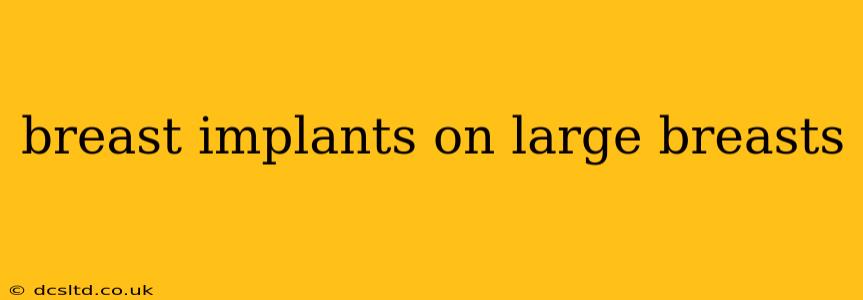Many women with naturally large breasts consider breast implant surgery, but their motivations often differ from those with smaller breasts. This isn't simply about increasing size; it's about reshaping, improving lift, or even reducing breast size while achieving a more aesthetically pleasing result. This comprehensive guide explores the nuances of breast implant surgery for women with larger breasts.
Why Would Someone with Large Breasts Want Implants?
This is a crucial question because the reasons differ significantly from women seeking breast augmentation to increase size. For women with already large breasts, implants might be sought for:
-
Breast Reduction/Lift Combination: Large breasts can lead to back pain, neck pain, and shoulder grooves. A breast reduction combined with implant placement can significantly alleviate these problems while also improving breast shape and lift. This procedure removes excess breast tissue, reducing weight and strain, while implants help restore volume and improve overall aesthetics. The implants aren't necessarily to make the breasts larger, but to improve the overall shape and projection after reduction.
-
Improved Breast Shape and Symmetry: Even naturally large breasts might lack symmetry or have uneven contours. Implants can help achieve a more balanced and aesthetically pleasing shape, addressing asymmetries or correcting drooping.
-
Addressing Ptosis (Sagging): Gravity takes its toll, and even naturally large breasts can experience significant sagging over time. Implants can help lift and reshape the breasts, providing a more youthful appearance.
-
Post-Pregnancy or Weight Loss Changes: Pregnancy and significant weight fluctuations can drastically alter breast shape and size, leading to sagging or loss of volume. Implants can help restore a more desirable shape and fullness.
What Types of Implants Are Suitable for Larger Breasts?
The choice of implant (shape, size, and type of fill) is crucial and is highly individualized, depending on the patient's anatomy, desired outcome, and surgeon's recommendations. A qualified plastic surgeon will assess the breast tissue density and overall anatomy to determine the best implant choice. Factors considered include:
-
Implant Placement: Submuscular (under the pectoral muscle) or subglandular (under the breast tissue) placement might be considered depending on the patient's anatomy and the surgeon's judgment. Submuscular placement can offer better support and a more natural look in some cases, particularly with larger implants.
-
Implant Fillers: Saline-filled or silicone-filled implants are options. Silicone implants generally offer a more natural feel and shape, but both have their advantages and disadvantages that should be discussed with a surgeon.
-
Implant Shape: Round or anatomical (tear-drop) implants might be considered. The best shape depends on the individual's anatomy and desired outcome.
Are There Higher Risks Associated with Implants on Larger Breasts?
While the risks associated with breast augmentation are generally similar regardless of breast size, certain aspects might be heightened in cases of larger breasts:
-
Increased risk of capsular contracture: This is the formation of scar tissue around the implant, potentially causing pain, hardening, and distortion. The risk might be slightly increased with larger breasts due to the greater volume and increased stress on the tissue.
-
Greater tissue manipulation: The surgery might involve more extensive tissue manipulation, potentially increasing the risk of complications such as bleeding or infection.
What is the Recovery Process Like?
The recovery process for breast implant surgery is similar regardless of pre-operative breast size; however, larger breasts might result in slightly longer recovery times due to more significant tissue manipulation. Patients can typically expect:
- Post-operative pain and swelling: This is common and usually managed with medication.
- Restricted activity: Patients need to limit strenuous activities for several weeks to allow for healing.
- Follow-up appointments: Regular follow-up visits with the surgeon are crucial to monitor healing and address any concerns.
What are the Long-Term Effects?
Long-term effects vary from patient to patient. Regular check-ups with a surgeon are crucial to monitor implant integrity and address any long-term issues.
How Much Does Breast Implant Surgery for Larger Breasts Cost?
The cost varies significantly based on location, surgeon's fees, and type of implants used. It's crucial to obtain a detailed cost breakdown from the surgeon before proceeding with the surgery.
This information is for educational purposes only and does not constitute medical advice. It is essential to consult with a qualified plastic surgeon to discuss your individual needs and determine the best course of action for your specific circumstances. Only a qualified professional can assess your unique anatomy and advise on the suitability of breast implants.
